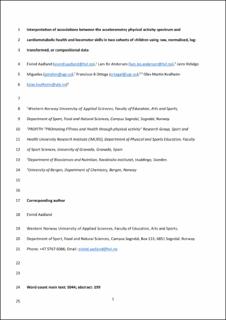| dc.contributor.author | Aadland, Eivind | |
| dc.contributor.author | Andersen, Lars Bo | |
| dc.contributor.author | Migueles, Jairo Hidalgo | |
| dc.contributor.author | Ortega, Francisco B. | |
| dc.contributor.author | Kvalheim, Olav Martin | |
| dc.date.accessioned | 2021-01-29T13:52:29Z | |
| dc.date.available | 2021-01-29T13:52:29Z | |
| dc.date.created | 2020-08-22T12:17:49Z | |
| dc.date.issued | 2020 | |
| dc.identifier.citation | Aadland, E., Andersen, L. B., Migueles, J. H., Ortega, F. B., & Kvalheim, O. M. (2020). Interpretation of associations between the accelerometry physical activity spectrum and cardiometabolic health and locomotor skills in two cohorts of children using raw, normalized, log-transformed, or compositional data. Journal of Sports Sciences, 38(23), 2708-2719. | en_US |
| dc.identifier.issn | 0264-0414 | |
| dc.identifier.uri | https://hdl.handle.net/11250/2725403 | |
| dc.description | This is an Accepted Manuscript of an article published by Taylor & Francis in Journal of Sports Sciences on 29 Jul 2020, available online: http://www.tandfonline.com/10.1080/02640414.2020.1796462. | en_US |
| dc.description.abstract | It is discussed whether associations between accelerometer-derived physical activity intensities and outcomes should be analysed as absolute or relative data. The aim of the present study was to compare interpretation of association patterns of spectrum physical activity descriptions with outcome using raw, normalized, log-transformed, or compositional data. We used two datasets including 1) 841 schoolchildren and a cardiometabolic health outcome and 2) 1081 preschool children and a locomotor skill outcome. Accelerometry (ActiGraph GT3X+) data were described using multiple variables across the intensity spectrum. We varied the binning of variables to examine sensitivity of the compositional analyses to changes in the distribution centre. We used multivariate pattern analysis for all analyses and interpretations of data. Analyses of absolute (i.e., non-compositional) data showed weak associations for lower intensities and strongest associations with cardiometabolic health and locomotor skills for vigorous intensities. The same association patterns were partly observed for the compositional data, but association patterns were in some cases conflicting. The binning of variables had a major influence on associations for compositional data, but not for absolute data, meaning that conclusions depend on the operationalization of compositional data. These differences challenge and confuse interpretation of association patterns derived from the different approaches. | en_US |
| dc.language.iso | eng | en_US |
| dc.publisher | Taylor & Francis | en_US |
| dc.title | Interpretation of associations between the accelerometry physical activity spectrum and cardiometabolic health and locomotor skills in two cohorts of children using raw, log-transformed, or compositional data | en_US |
| dc.type | Peer reviewed | en_US |
| dc.type | Journal article | en_US |
| dc.description.version | acceptedVersion | en_US |
| dc.source.pagenumber | 2708-2719 | en_US |
| dc.source.volume | 38 | en_US |
| dc.source.journal | Journal of Sports Sciences | en_US |
| dc.source.issue | 23 | en_US |
| dc.identifier.doi | 10.1080/02640414.2020.1796462 | |
| dc.identifier.cristin | 1824599 | |
| dc.relation.project | Gjensidige forsikring: 1042294 | en_US |
| dc.relation.project | Norges forskningsråd: 221047 | en_US |
| cristin.ispublished | true | |
| cristin.fulltext | postprint | |
| cristin.fulltext | postprint | |
| cristin.qualitycode | 1 | |
